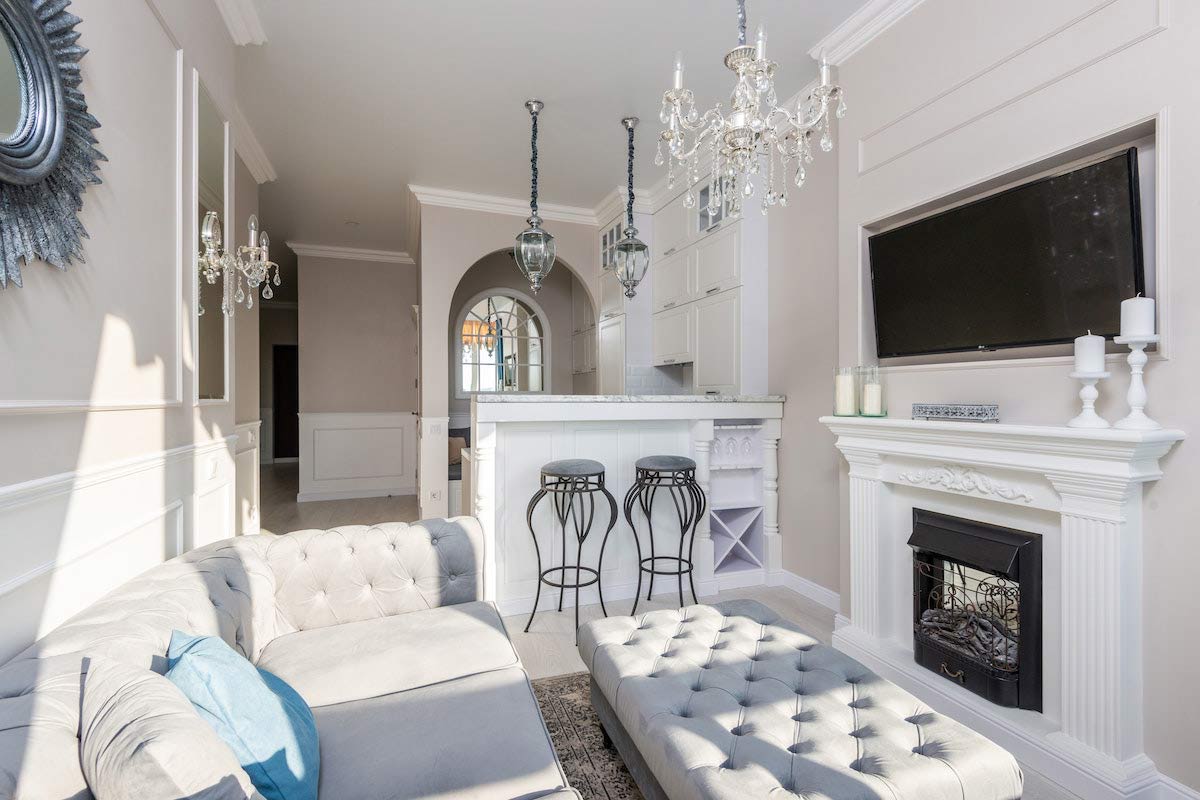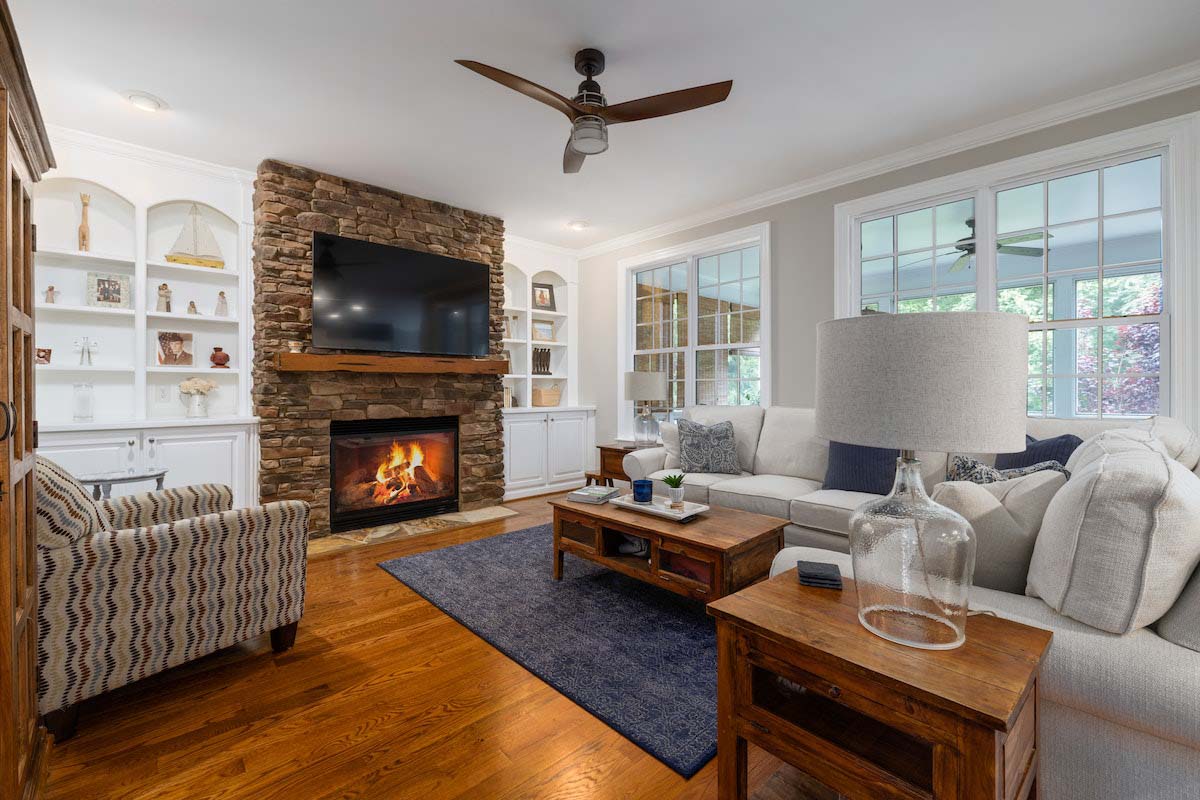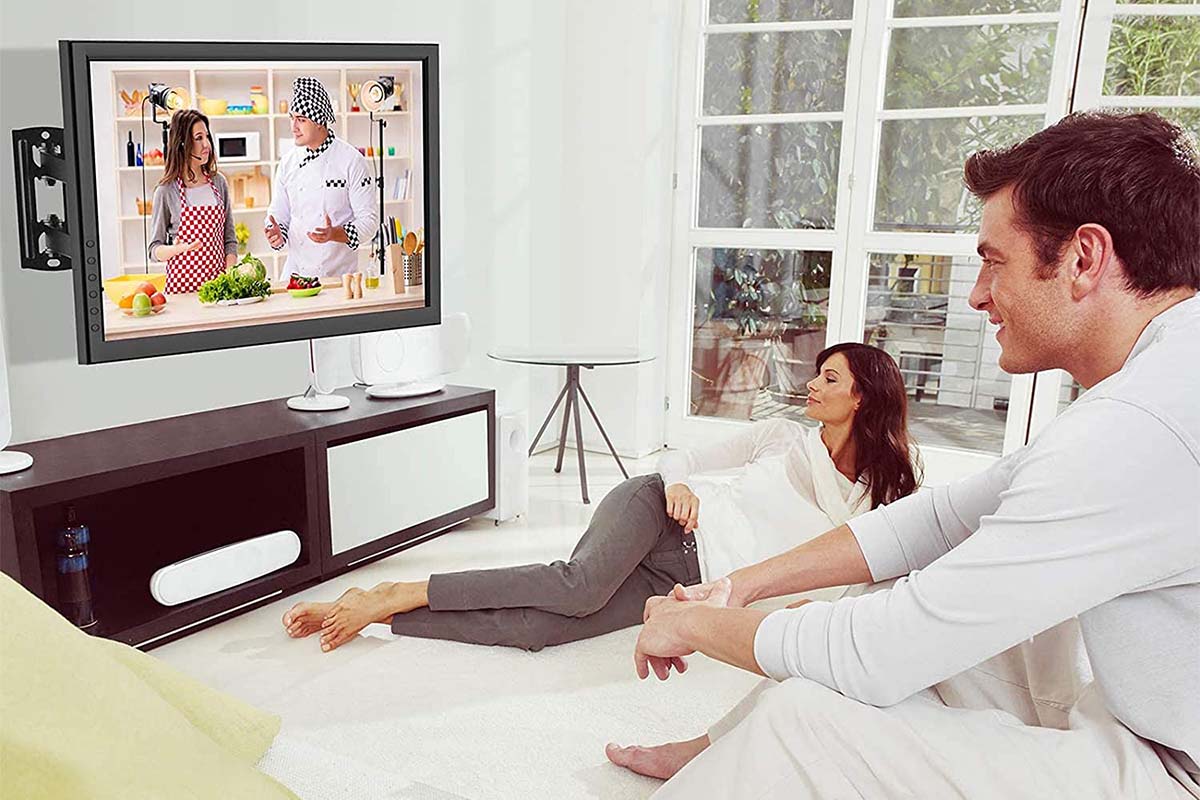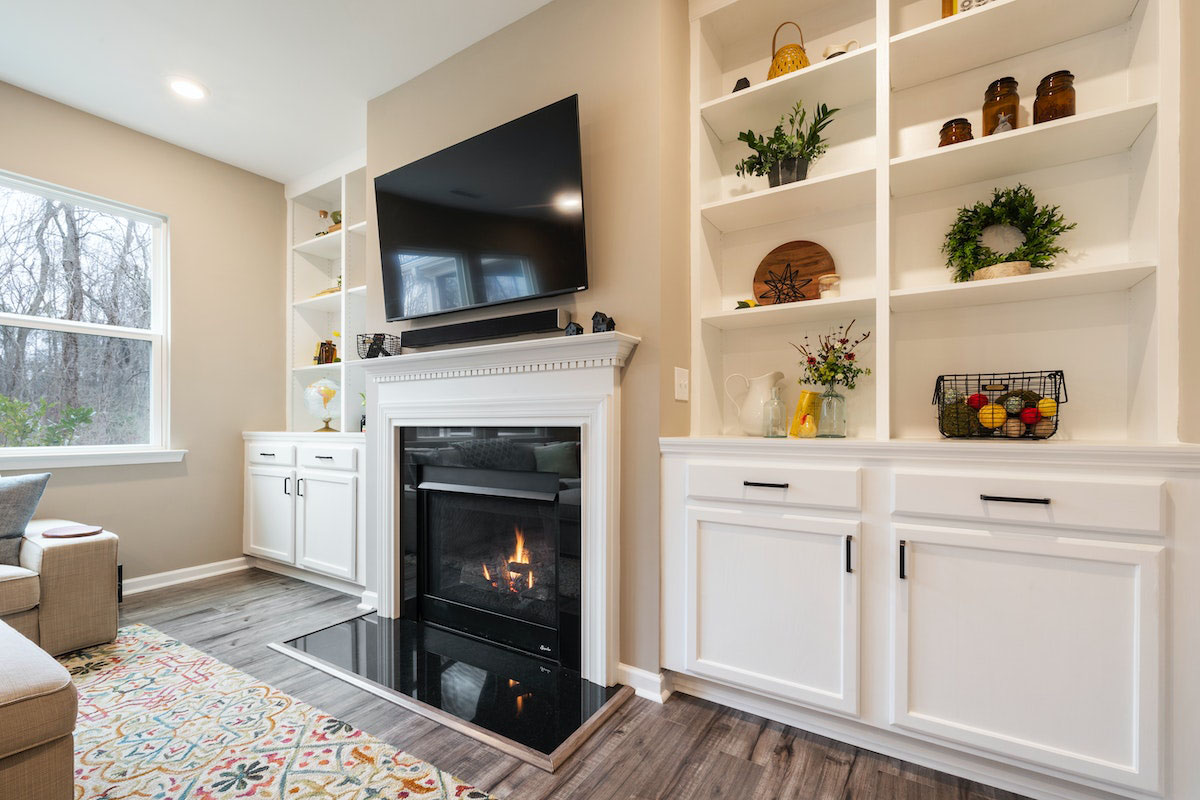Mounting a TV above a fireplace has become a popular choice for many homeowners, a great idea for creating a stylish and space-saving solution. However, before embarking on this design trend, it’s crucial to consider various factors and explore the options available.
In this article, we will delve into the topic of mounting a flat screen TV above a fireplace, specifically focusing on wood-burning fireplaces, gas fireplaces, and electric fireplaces.
We will discuss the benefits, considerations, and important factors to keep in mind for each type of fireplace.
So, let’s dive in and discover if the best idea of mounting a TV above a fireplace is the right choice for you.
Can You Mount a TV Above a Wood Burning Fireplace?

Wood-burning fireplaces exude a traditional charm and provide a cozy ambiance. However, they also generate a significant amount of heat and emit smoke and sparks.
Mounting a TV above a wood-burning fireplace requires careful consideration due to the heat and potential damage to other electronics around the TV.
We’ll delve into the benefits and considerations of wood-burning fireplaces and discuss measures to address heat-related concerns.
Exploring Wood-Burning Fireplaces
Wood-burning fireplaces are known for their timeless appeal, bringing warmth and coziness to any space.
These traditional fireplaces offer the crackling sound of burning wood and the natural beauty of a real fire. However, when it comes to mounting a TV above a wood-burning fireplace, there are several considerations to keep in mind.
The high heat output and the potential for smoke and sparks pose challenges, and proper ventilation is essential for both the fireplace and the TV.
Gas Fireplaces: A Convenient Alternative
Gas fireplaces have gained popularity due to their convenience and ease of use. With gas fireplaces, you can enjoy the benefits of controlled and adjustable heat output. They do not produce smoke or sparks, making them a suitable option for mounting a TV above the fireplace.
However, it is important to manage heat effectively and ensure proper ventilation when considering TV placement with gas fireplaces.
Electric Fireplaces: The Charm of Convenience
Electric fireplaces offer a modern and hassle-free alternative to traditional fireplaces. They provide the charm of a fireplace without real flames or smoke. Electric fireplaces are considered safe for TV mounting due to the absence of heat emissions, making them an attractive option.
However, factors such as heat dissipation, surface temperature, electrical connections, and optimal positioning of the TV should be taken into account for a successful installation.
Benefits and Considerations of Wood-Burning Fireplaces
- Traditional ambiance: Wood-burning fireplaces create a cozy and inviting atmosphere with the crackling sound and natural beauty of a real fire.
- Natural warmth: The radiant heat produced by wood-burning fireplaces provides a comforting and authentic warmth.
- Energy independence: Wood is a renewable resource, making wood-burning fireplaces a more sustainable heating option.
- Cost-effective: Wood can often be a more affordable fuel source compared to gas or electricity.
- Aesthetic appeal: The visual charm of a wood-burning fireplace adds character and enhances the overall décor of a space.
Key Factors to Consider with Gas Fireplaces
When considering mounting a TV above a gas fireplace, there are several key factors to keep in mind.
- Heat management: Proper heat management is crucial when mounting a TV above a gas fireplace to ensure that the TV is not exposed to excessive heat.
- Ventilation requirements: Adequate ventilation is necessary for gas fireplaces to function safely and effectively, and this should be taken into account for both the fireplace and TV.
- Gas fireplace design: Different gas fireplace designs, such as open or closed systems, may impact the suitability of TV placement and the heat generated.
- Professional installation: Gas fireplace installations should be carried out by certified professionals to ensure compliance with safety standards and proper functioning.
- Remote control options: Many gas fireplaces offer convenient remote control options for easy operation and heat adjustment.
Mounting a TV Above an Electric Fireplace: Things to Know

Electric fireplaces offer convenience and versatility, making them a popular choice for modern homes.
- Heat dissipation: Electric fireplaces may generate heat, and proper heat dissipation measures should be considered to prevent any impact on the TV.
- Electrical connections: Ensuring appropriate electrical connections and outlets are available is essential for safe and reliable TV installation.
- Optimal TV positioning: Placing the TV at an appropriate height and angle for optimal viewing is important for a comfortable and enjoyable TV-watching experience.
- Weight and stability: Electric fireplaces often have mantels or shelves that can support the weight of a TV, but it is crucial to ensure stability and secure mounting to prevent accidents.
- Remote control and settings: Electric fireplaces offer convenience through remote control options and customizable settings, allowing you to adjust heat levels and flame effects according to your preferences.
Heat and Its Impact on TV Placement
Heat significantly affects TV placement above a fireplace, impacting performance and lifespan. Excessive heat can damage sensitive components.
Maintain the recommended distance between the TV and fireplace to minimize exposure. Consider heat shielding and ventilation to protect the TV and ensure optimal placement.
Maintaining Optimal Viewing Height
The recommended viewing height for TV placement above a fireplace is typically eye level when seated.
Mounting the TV too high can strain the neck and cause neck pain and discomfort during extended viewing sessions. To achieve the optimal viewing height, measure the distance from the floor to eye level when seated in your preferred viewing spot. Ideally, the center of the TV screen should align with this measurement.
It’s essential to consider factors such as the amount fireplace wall height, furniture arrangement, and personal preferences. Adjusting the TV’s height accordingly ensures a comfortable and enjoyable viewing experience for everyone in the room.
Ensuring Proper Ventilation for Both TV and Fireplace
Proper ventilation is essential for both the TV and the fireplace when mounting a TV above a fireplace. The fireplace requires ventilation to exhaust smoke and heat, while the TV needs airflow to prevent overheating.
Clearing obstructions and providing adequate clearance helps maintain optimal performance and longevity for both the TV and the fireplace. Following manufacturer guidelines ensures proper ventilation and adherence to safety standards.
Addressing Safety Concerns: Heat Shields and Insulation
Safety is a paramount concern when mounting a TV above a fireplace. Heat shields and insulation are key components for addressing these safety concerns.
Heat shields deflect and dissipate heat, protecting the TV from excessive heat exposure. Insulation acts as a buffer, minimizing heat transfer to the TV.
When installing a TV above a fireplace, it is vital to choose suitable heat shields and insulation materials, following safety standards to ensure a safe and protected setup.
Understanding Wall-Mounted TV Brackets

Understanding wall TV mounted brackets is essential for a secure and reliable TV installation. Different types of brackets are available, including fixed, tilt, and full-motion brackets. Fixed brackets offer a flush mount, while tilt brackets provide vertical adjustment.
Full-motion brackets offer the most flexibility with tilt, swivel, and extension capabilities. It’s important to choose a bracket that matches your TV’s size and weight.
Proper installation, ensuring attachment to wall studs or structural supports, is crucial for stability. By understanding the different bracket options and installation considerations, you can select the right bracket for a safe and successful wall-mounted TV setup.
Choosing the Right Wall Mount for Your TV
Choosing the right wall TV mount is crucial for a secure and successful installation. There are various types of TV wall mounts available, including fixed, tilt, and full-motion mounts.
Fixed mounts provide a simple and flush mount, while tilt mounts allow for vertical adjustment. Full-motion mounts offer the most flexibility, enabling you to tilt, swivel, and extend the TV for optimal positioning.
When selecting a wall mount, consider the size and weight of your TV to ensure compatibility. Additionally, ensure that the mount is properly installed, securely attached to the wall studs or other structural supports.
Optimal Viewing Angle and Positioning

When mounting a TV above a fireplace, achieving the optimal viewing angle and positioning is essential. The ideal viewing distance and angle ensures a comfortable and immersive TV-watching experience for everyone in the room.
When positioning the TV, it’s important to consider factors such as the room layout, seating arrangement, and the height of the fireplace. The TV should be placed at eye level or slightly below to prevent strain on the neck and eyes. Adjusting the screen and viewing angle helps minimize glare and reflections, enhancing the overall picture quality.
Tilt or articulating TV mounts can fine-tune the angle and provide flexibility for adjusting the TV’s position.
Handling Excessive Heat from the Fireplace
Handling excessive heat from the fireplace is a critical consideration when mounting a a TV over a fireplace above it. Excessive heat can negatively impact the TV’s performance and lifespan. To mitigate this, several strategies can be employed.
One option is using heat-resistant materials, such as heat shields or mantel shelves, to create a barrier between the fireplace and the TV. This helps redirect and dissipate the heat away from the TV.
Additionally, ensuring there is sufficient airflow and an adequate air gap between the TV and the fireplace helps prevent heat buildup. Proper ventilation for the fireplace and the TV is essential to maintain optimal performance and prevent overheating.
Implementing these strategies can minimize the risk of heat damage to the TV. You can watch TV safe and enjoyable in a minimum distance from fireplace mounting.
Addressing Potential Glare Issues
Addressing potential glare issues is crucial when mounting a TV above a fireplace. Glare can significantly impact the viewing experience by causing reflections and reducing the clarity of the screen. To minimize glare, several strategies can be employed.
One approach is to position the TV at an angle that reduces the direct reflection of light sources, such as windows or overhead lighting. Additionally, using curtains, blinds, or adjustable lighting can help control the amount of ambient light in the room.
Anti-glare screen protectors or matte screen finishes can also be applied to the TV to reduce glare. It’s important to experiment with different solutions and adjust the room’s lighting to find the optimal balance that minimizes glare and maximizes picture quality.
Considerations for Placing the TV Adjacent to the Fireplace
When mounting the TV directly above the fireplace is not feasible or preferred, placing it adjacent to the fireplace is an alternative worth considering. However, several factors should be taken into account.
First, the distance between the TV and the fireplace needs to be carefully determined to ensure comfortable viewing angles and prevent heat-related issues. Additionally, heat management remains important, as the fireplace’s heat output may still affect the TV.
Adequate ventilation and proper airflow should be maintained to prevent overheating. By considering these factors and finding the optimal positioning, placing the TV adjacent to the fireplace allows for a functional and visually appealing setup that balances the room’s focal points.
Utilizing Furniture or Shelving for TV Placement
Utilizing furniture or shelving for TV placement offers a practical and versatile alternative when TV mounted above a fireplace is impossible.
By incorporating fireplace mantel or installing shelves near the fireplace, you can create a dedicated space for the TV that complements the room’s layout and design.
This approach allows for optimal viewing height and angle watching television, while fireplace mantel provides storage options for cables and peripherals. It helps create a functional and visually appealing entertainment area seamlessly integrating with the room’s decor.
Exploring Other Rooms for TV Installation
If mounting a flat screen TV just above the brick fireplace still proves to be impractical or undesirable, exploring other rooms for TV installation can provide alternative solutions.
Consider rooms such as a dedicated media room, living room, or bedroom, where the TV can be the focal point without the challenges posed by a fireplace. Assessing the layout and design of these rooms allows for flexibility in the TV size and placement, ensuring optimal viewing angles and accommodating furniture arrangements.
Whether it’s creating a cozy media room or transforming the living room into an entertainment center, exploring other rooms opens up possibilities for a customized and comfortable TV-watching experience.
Conclusion: Pros and Cons of Mounting a TV Above a Fireplace
In conclusion, mounting a TV above a fireplace has its pros and cons. It saves space and enhances the crackling fire viewing experience, but there are concerns regarding heat damage, viewing angles, and glare. It’s crucial to weigh these factors and take necessary precautions for a successful installation.
Consulting professionals can help address any safety concerns and ensure a satisfactory outcome.






